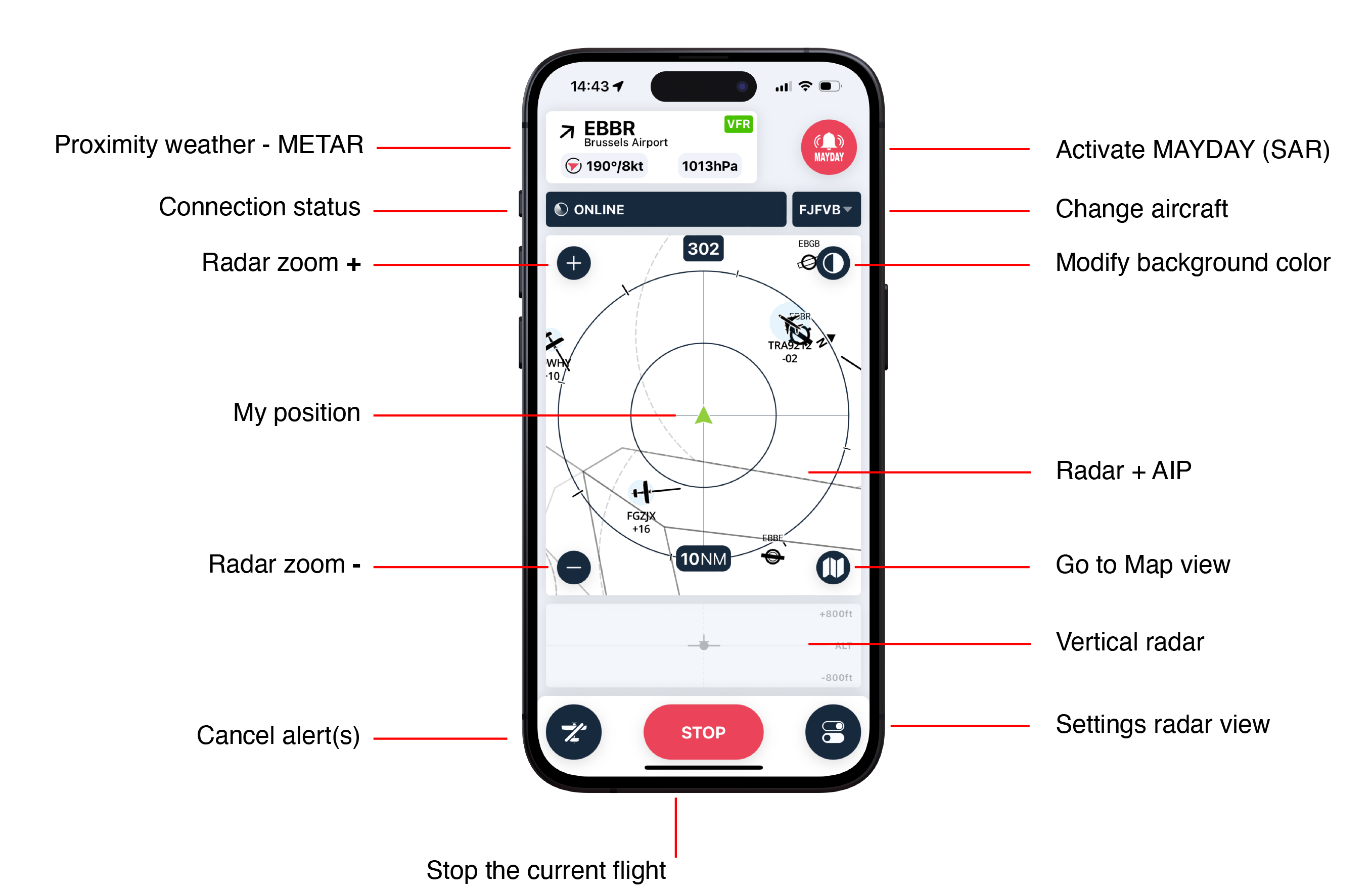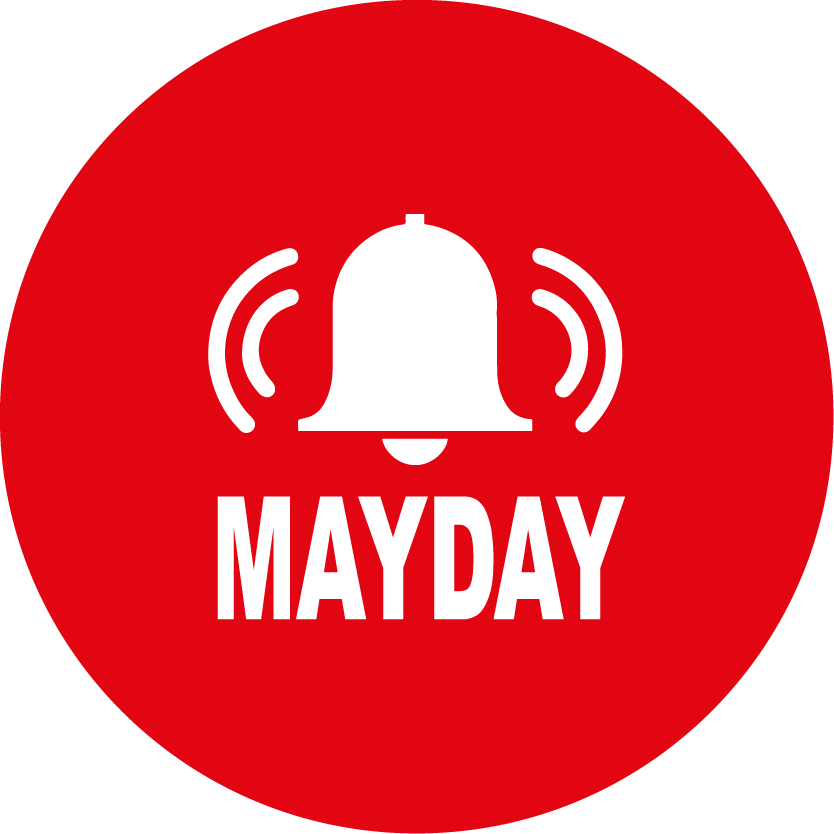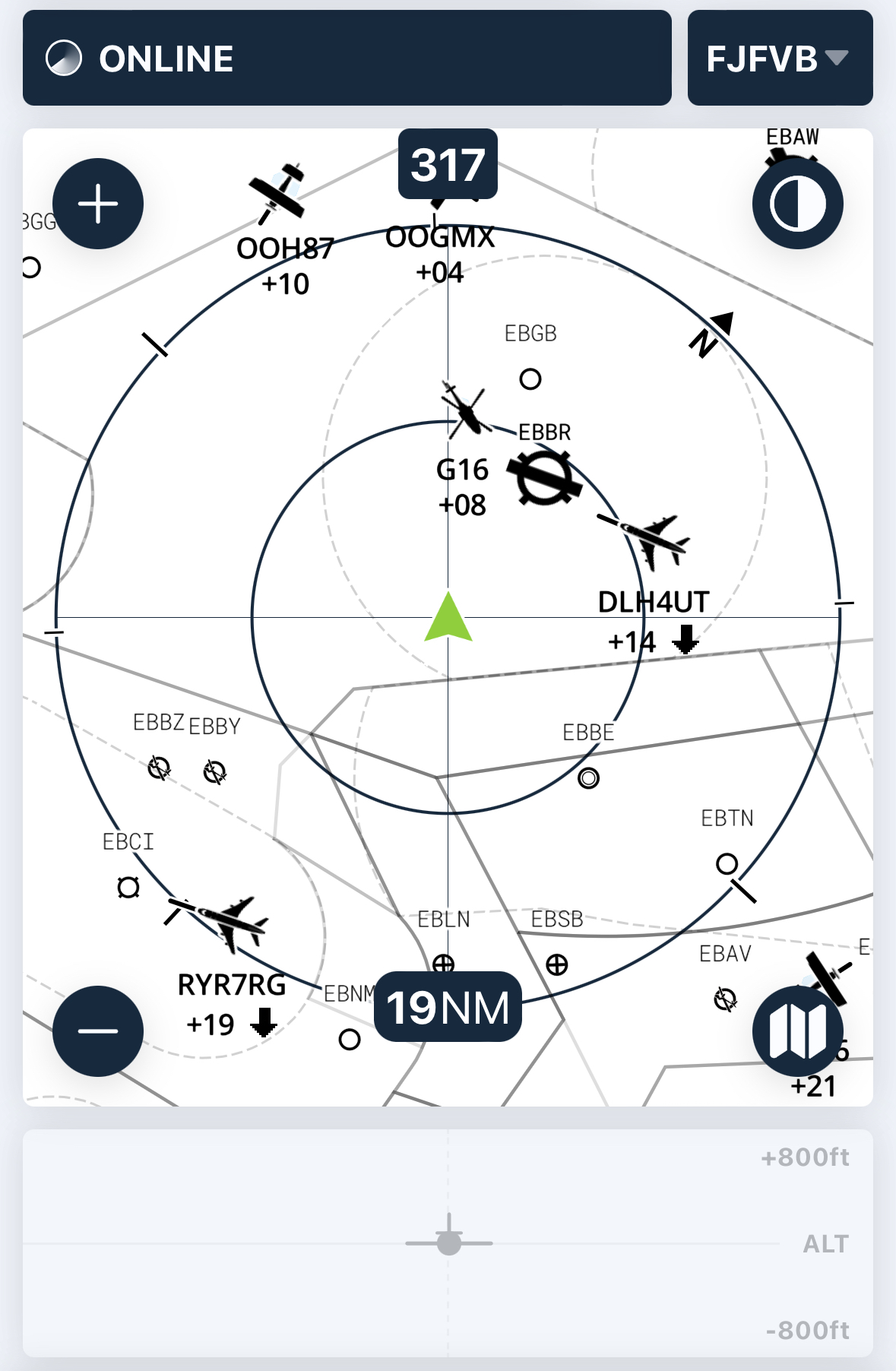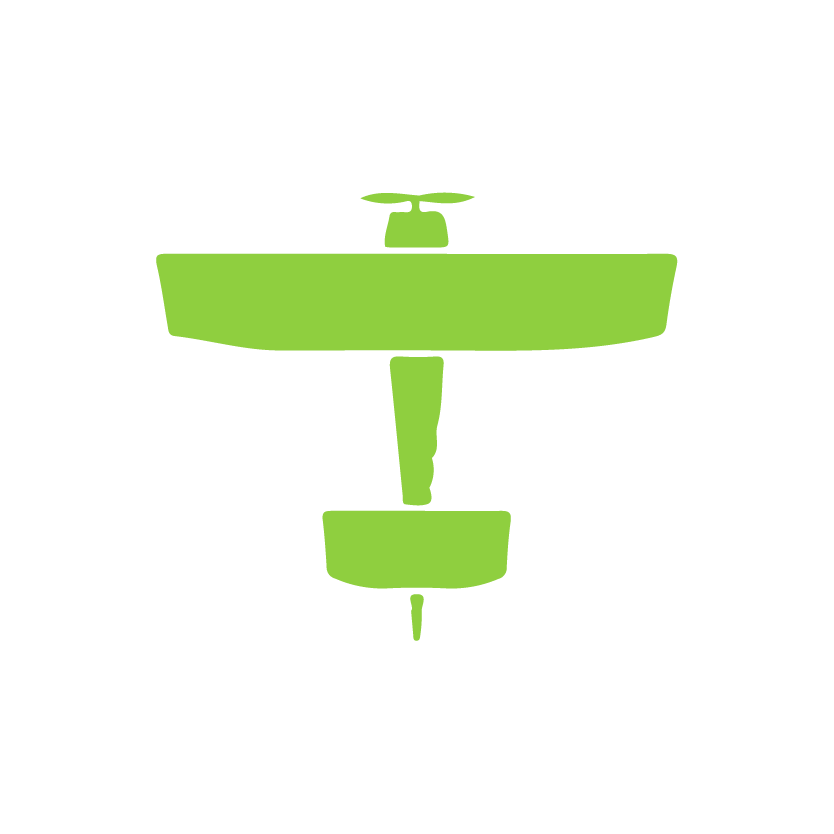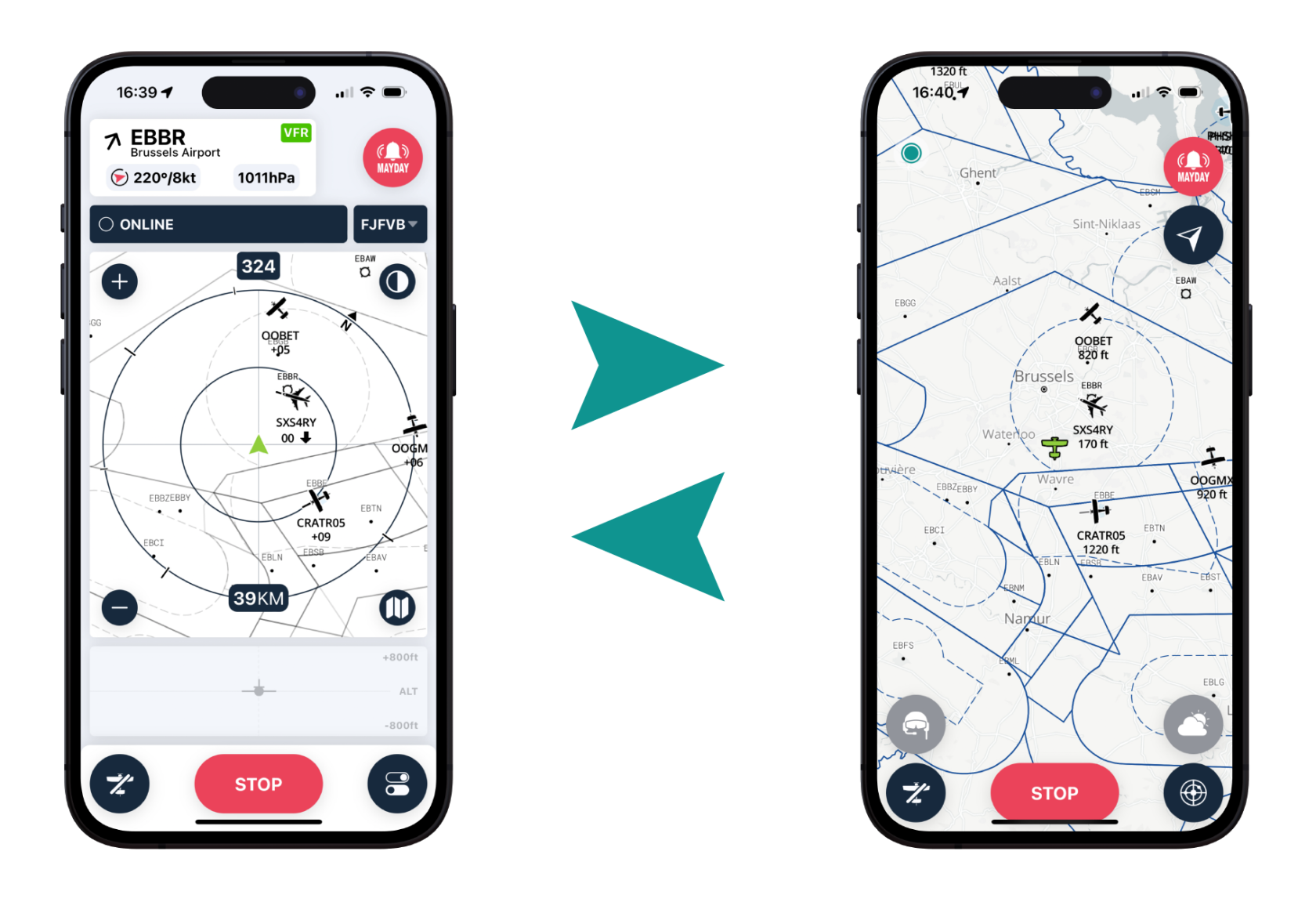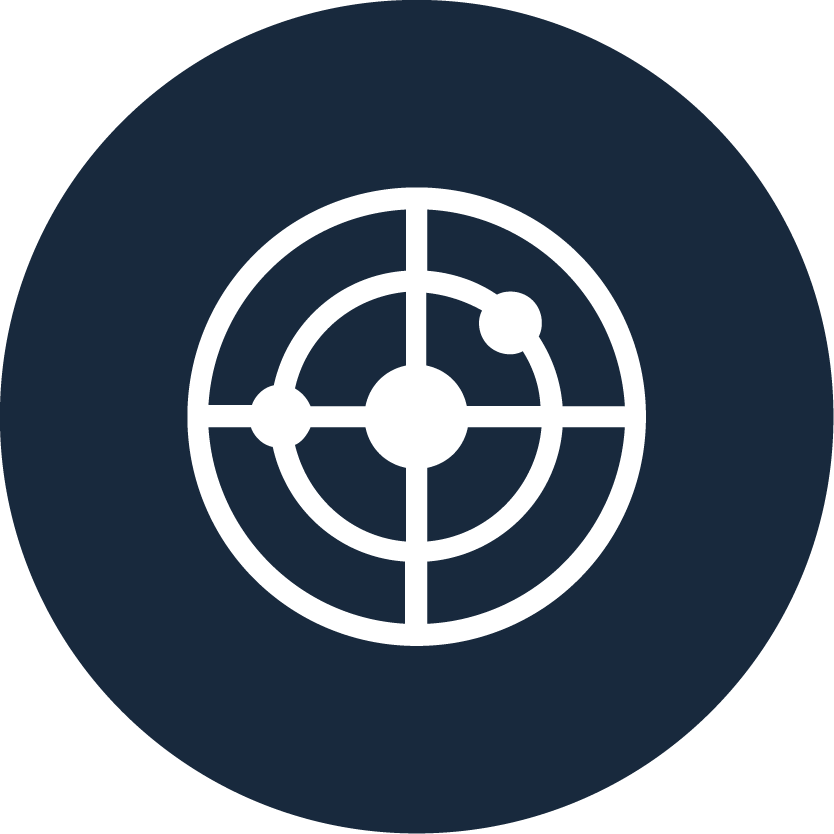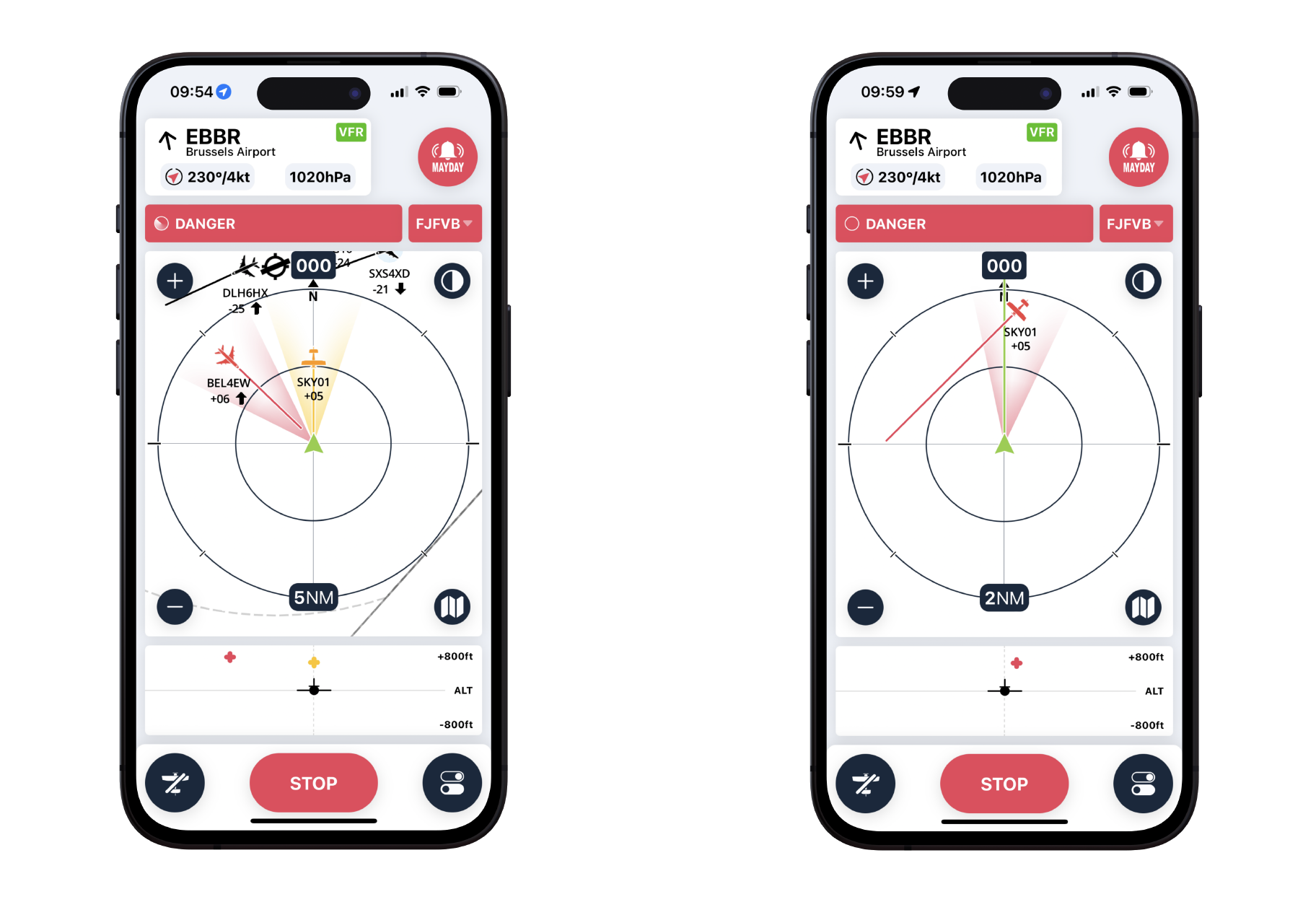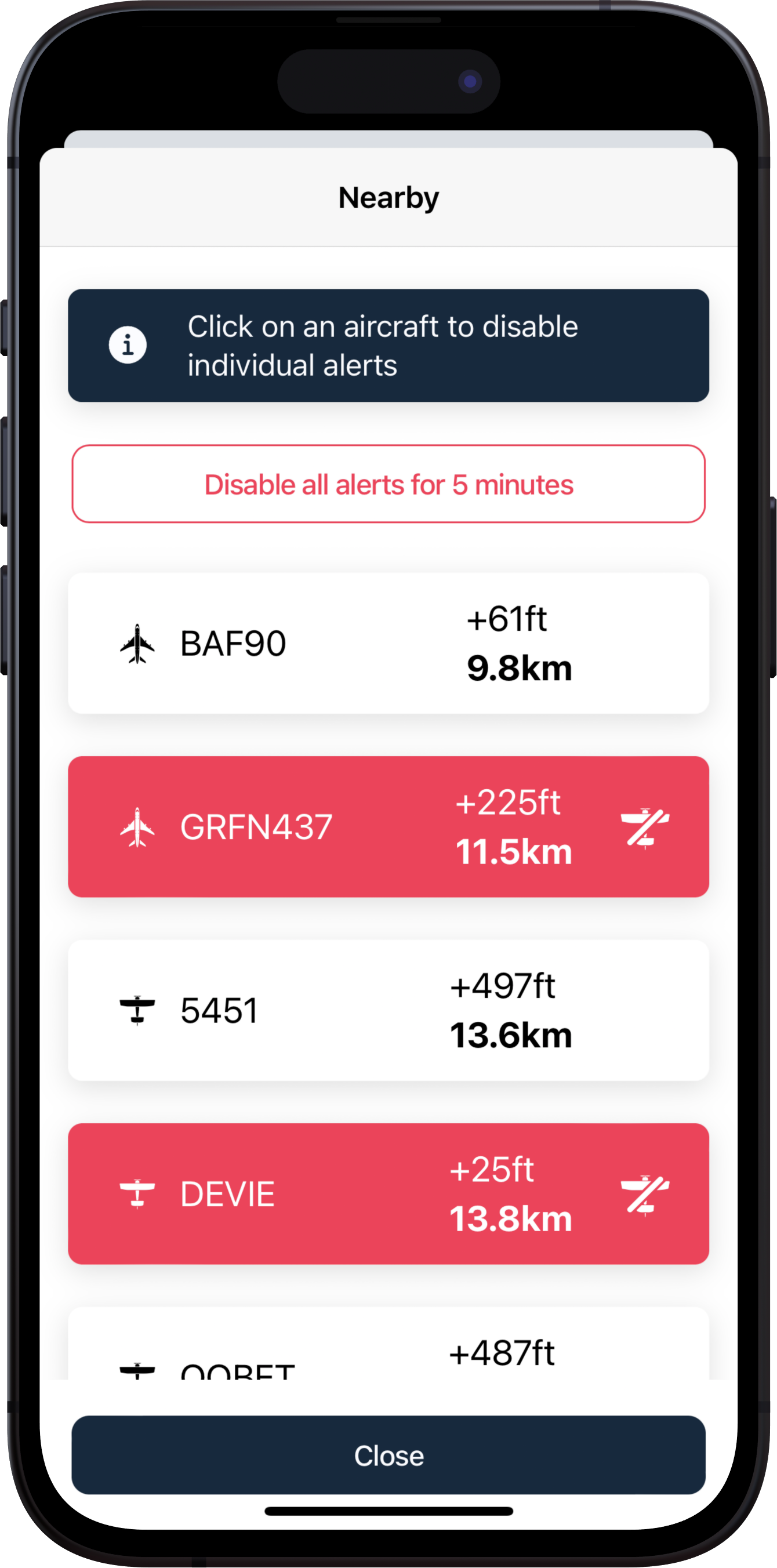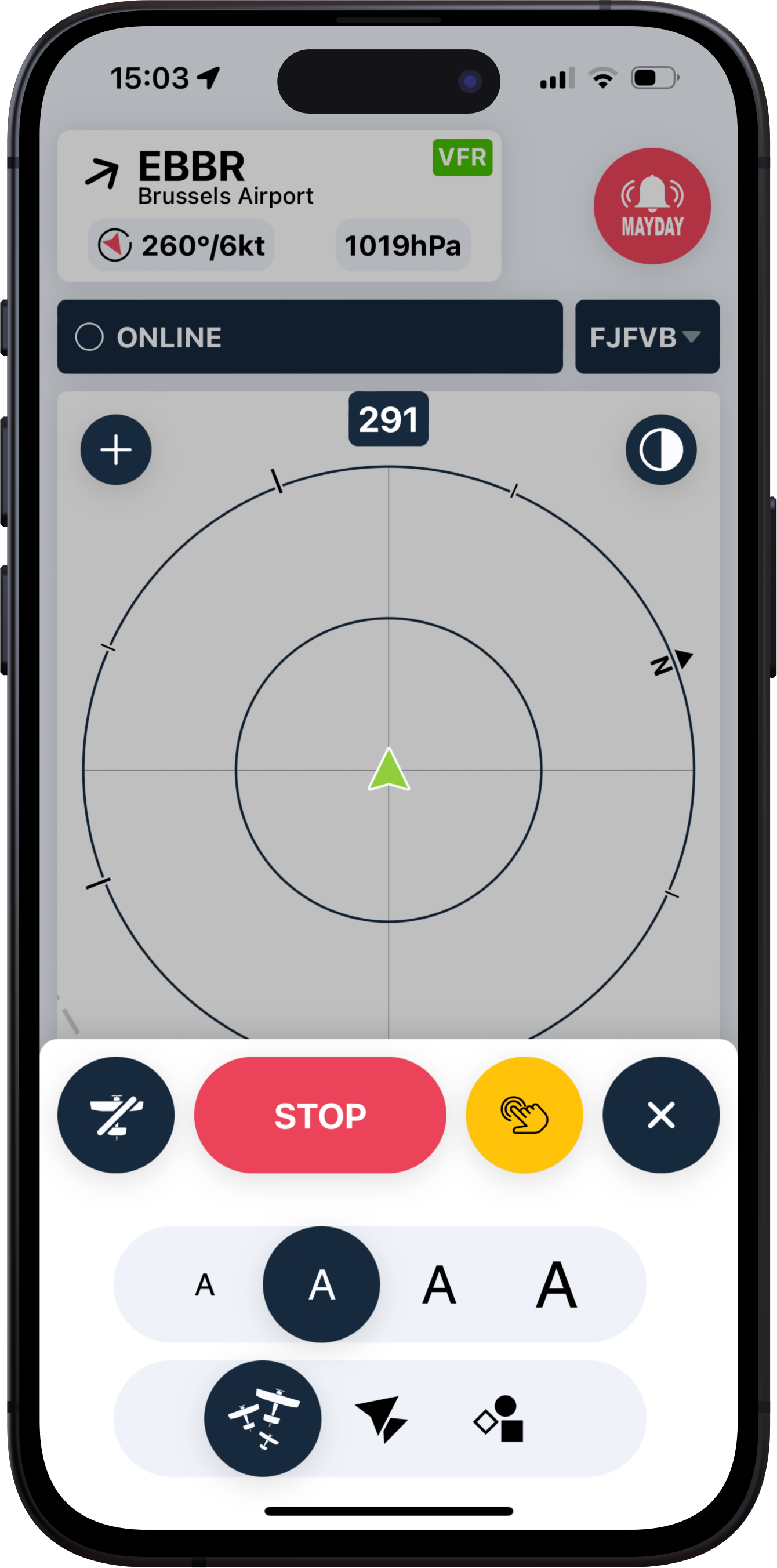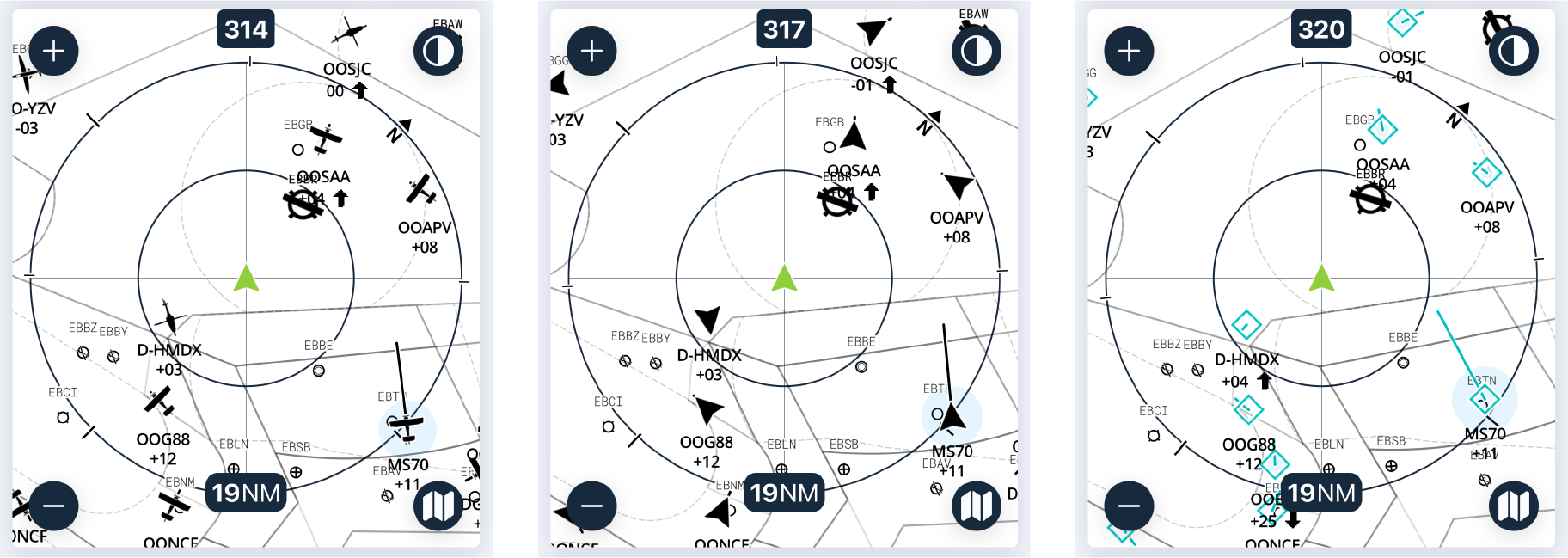Radar screen
After hitting "TAKE OFF", the application will automatically display the radar screen.
Nearby weather - METAR/TAF
Nearby weather is displayed dynamically as your flight progresses. You'll receive the following information:
- METAR station (ICAO code + name)
- Weather conditions (VFR-MVFR-IFR)
- Wind strength and direction: the red arrow tells you which direction the wind is blowing, depending on your trajectory
- QNH from the weather station
This feature is activated with the PREMIUM version.
Activate SAR (Search & Rescue)
Press this button during flight if you find yourself in a situation that could lead to an emergency landing. Simply activating SAR will trigger a series of actions detailed in the "Settings" section.
This feature is active in both the free and PREMIUM versions.
Connection status
This dot informs the pilot of the connection status, which can be either green or red, depending on its activity.
By clicking on the dot, a sub-window appears with additional information:
- Internet: indicates the status and activity of the internet connection.
- SafeSky: provides information about the last exchange with SafeSky servers.
- My position: confirms if the mobile device's GPS is properly transmitting its position.
- <Navigation Software>: confirms the choice and connection to the selected navigation software in the application Settings.
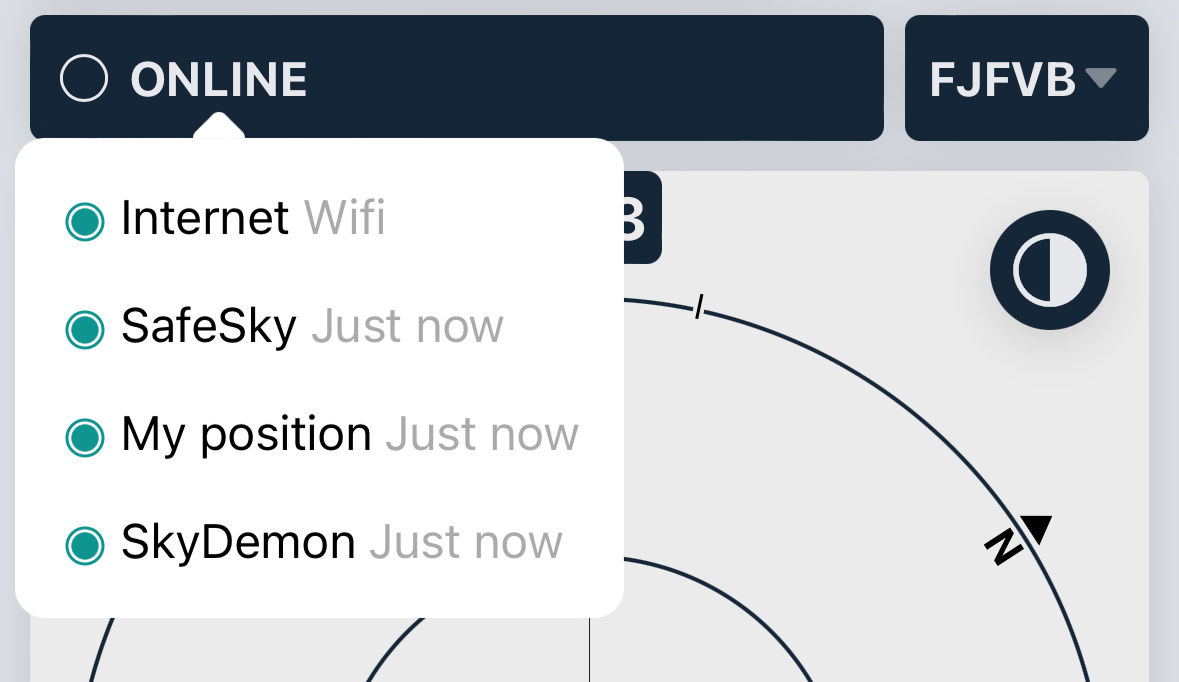
Change aircraft
If you are flying multiple aircraft, ensure you select the correct one in the SafeSky App. In case you forgot, you can switch aircraft during the flight by accessing the list of registered aircraft. Using the correct aircraft configuration is crucial to ensure the proper hexadecimal registration code is used.
If your SafeSky configuration is not linked to your hexadecimal code or registration number, there is a risk of your aircraft being detected twice. This can be confusing for both you and other pilots.
Modify background color
Depending on the outside brightness, you can select either a black or white radar background.
My position
The center of the radar represents your position relative to the surrounding traffic, indicated by a green triangle. In map mode, your aircraft icon will also be green.
Radar zoom
Press "+" and "-" to decrease or increase the visible traffic distance on the radar. There are 4 zoom levels with the following scales:
- Up to +/- 0.5 nautical mile, or +/- 1 km
- Up to +/- 1 nautical mile, or +/- 2 km
- Up to +/- 2 nautical miles, or +/- 5 km
- Up to +/- 5 nautical miles, or +/- 10 km
- Up to +/- 10 nautical miles, or +/- 20 km
- Up to +/- 20 nautical miles, or +/- 40 km
- Up to +/- 40 nautical miles, or +/- 80 km
Quick Reminder: At 120 knots, an aircraft covers 1 nautical mile in 30 seconds of flight. It is, therefore, easy to calculate that an aircraft located within 2 nautical miles is approximately 1 minute of flight away (+/-). Of course, the speed of the aircraft is an important factor, and the speed vector should help you assess this distance/flight duration.
Go to map view
During the flight, you can switch from the radar screen to the map and vice versa by clicking on this symbol ![]() .
.
Radar
Radar representation using concentric circles incorporating the NORTH position, as well as the aircraft's course and the radar's largest radius (in our case below, 19NM). The radar can be configured in nautical miles (NM) or kilometres (kms).
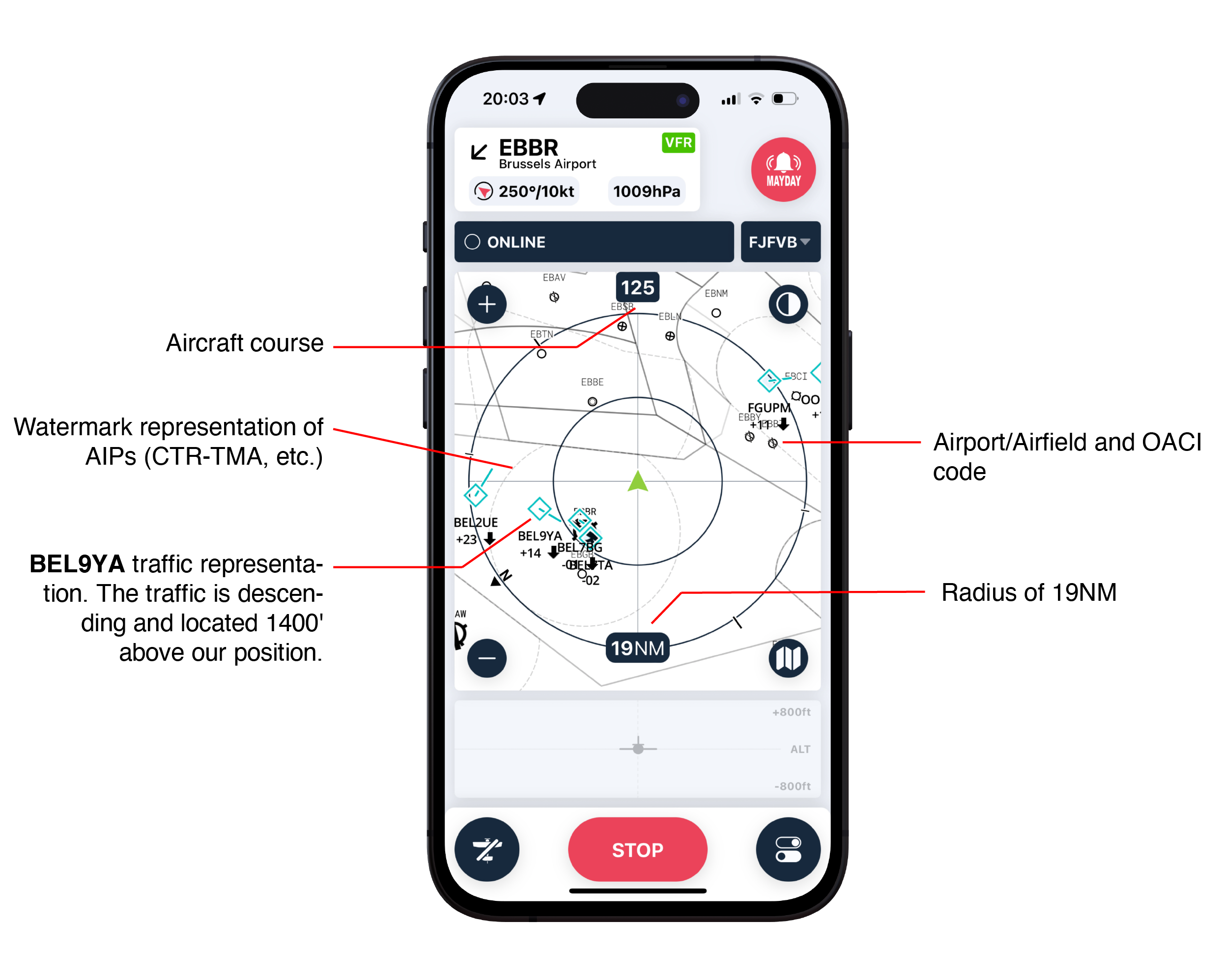 The radar will display the following elements:
The radar will display the following elements:
-
Traffic:
ShownIconsas icons representing the type ofrepresent visible aircraft,along withshowing their callsign and relative altitude compared to yourcurrent position in flight.position. For example, +04indicates thatmeans thetrafficaircraft is 400 feethigherabovethan your position,you, while -12 means it is 1,200 feet lower. -
Airports: Airports are
representedmarked with their ICAO code, runway surface type, and orientation. A dashed line indicates a grass runway,whileand a solid line indicates a paved runway.IfClickthere is a METAR station aton theaerodrome, click on itairport to displaytheMETARinformation.information if available. - AIP: TMAs,
CTRsCTRs, and other zones are shown aswatermarks. The aim iswatermarks togiveprovide pilots with familiar landmarks..
Alerts
If traffic is too close to your position, an orange or red cone will precisely alert you ofindicate its position. An audible alert can also be configured if you are using a Bluetooth headset.
During alerts, the screen will be frozen until the danger has disappeared, allowing the pilot to focus on the external surroundings rather than the inside. The zoom level will be automatically adapted.
FREE Version
If you have opted for the FREE version of SafeSky, the radar will alert you by considering a protection radius around your position. The intensity of the alert will be adjusted according to the proximity of other devices. SafeSky worked in this way until version 2.
PREMIUM Version
In its PREMIUM version, SafeSky offers, since version 3, a brand new algorithm that takes into account proximity on the one hand, but also the velocity and direction of aircraft. The result of this new way of processing traffic is to reduce the number of alerts that are not real dangers, thereby improving safety. In circuit, this new algorithm is particularly effective!
If traffic is too close to your position, an orange or red cone will alert you to its exact location. An audible alert can also be configured if you have opted foruse a Bluetooth headset.
During alerts, the screen iswill frozenfreeze until the danger has passed, allowing you to ensure that the driver is concentratingfocus on the outsideexternal world and not on the application.surroundings. The zoom level iswill automatically adjusted.adjust.
FREE Version
In the FREE version of SafeSky, the radar alerts you based on a protection radius around your position. The alert intensity adjusts according to the proximity of other aircraft. SafeSky functioned this way until version 2.
PREMIUM Version
Since Version 3, the PREMIUM version of SafeSky uses a new algorithm that considers not only proximity but also the velocity and direction of aircraft. This reduces false alerts and improves safety, especially in circuit.
Traffic proximity alerts are both audible and visual. They can be intrusive if proximity is intentional, for example.example when flying in a squadron. In such cases, you can disable all traffic alerts. Click on the icon ![]() to access the detailed menu below:
to access the detailed menu below:
In this window, you cancan:
-
Deactivate all alerts for nearby aircraft for
a period of5 minutes. ByclickingClicking on the registration of an aircraft in the
list, youlist willcanceldisablethe maps onlyalerts forthethat specific aircraftselectedfor the duration of your flight.
Settings radarRadar view settings
Clicking on this icon gives you quick access to basic settingssettings, soallowing you canto easily configure the font size and type of illustration for the traffic display.
Here are the 3 possible traffic representations (aircraft, triangles or "TCAS"):
Stop your flight
At the bottom of thisthe screen, the red "STOP" button allows you to end your flight and stop sharing your position.
If you forget to stop the flight while grounded, the SafeSky application will automatically stop after 10 minutes of aerial inactivity.

